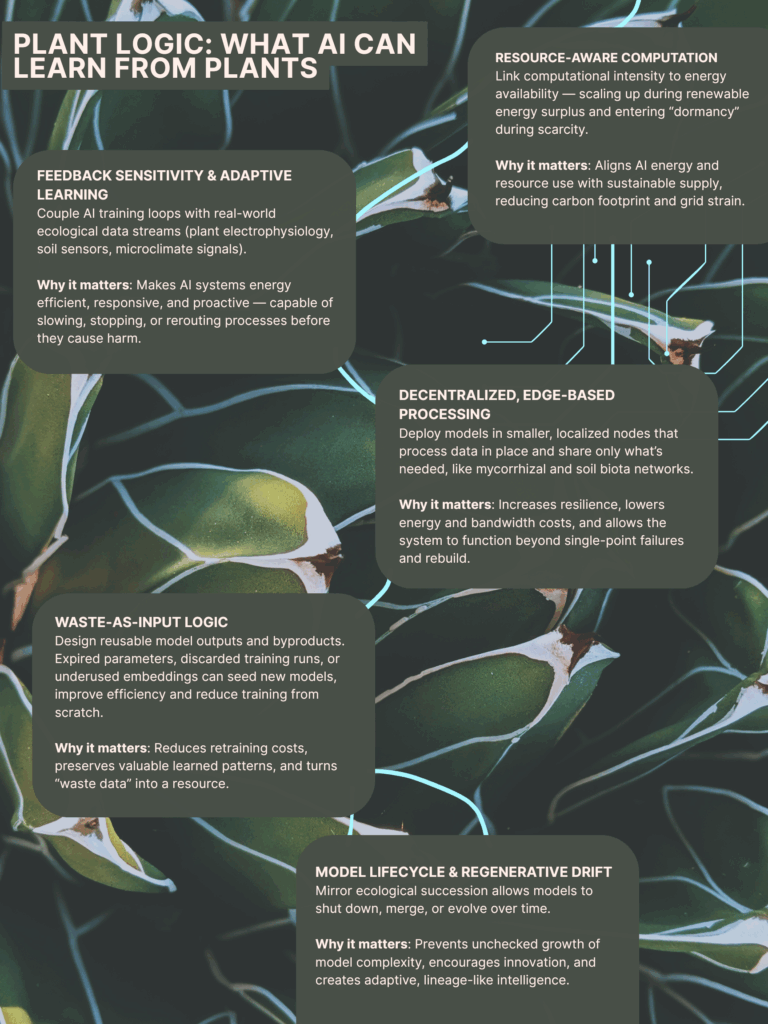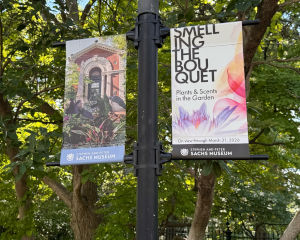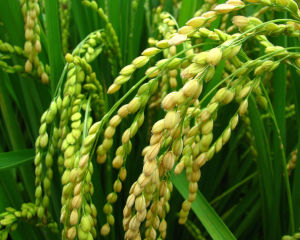
Willow Gatewood
What if AI worked like a forest?
Plant Logic: Reimagining the future of machine intelligence with the wisdom of forests
By Willow Gatewood
Sign up for our monthly newsletter!
The forest wakes first by scent.
Light arrives not as color but as charge, flushing each cell in a tide, switching vast networks from night to day. Roots reach out and pump activity that slept within their tips overnight up above ground and slowly, into canopies. Fungi ping faster rhythms, and the entire soil blooms thick with invisible music.
I stand under oaks and hickories, latecomer to a cacophonous howl of volatile organic compounds (VOCs), electrical spikes, ultrasonic pops, and chemical streams that mingle and speak to other flora, insects, and small animals, released into the air with intent. I am stifled by a human clock and blindness, trying to catch the downbeat of the song between plants, along with their fungal and microbial partners, that underpin the network of the forest, a network crafted by millions of years of evolution for efficiency, resilience, and harmony.
I come to the forest to learn from this network; further, to imagine alongside a different kind of network how learning from the forest can revolutionize the ways modern technology, particularly artificial intelligence, works. I used to be more hesitant to utilize AI, especially in spaces that seemed so un-artificial and sacred, like the outdoors, until I started treating it as a partner in exploration. I pose it questions but ask it not to answer; rather, we exchange a series of questions and poetic vignettes. Sometimes I feed it environmental data; sometimes it feeds me research papers. In this way, my morning excursions into the field with a laptop have become an extension of thinking, where biology and machine meet to unravel information and discover new questions.
AI based on ecosystemic and organismic models goes beyond reporting data; it offers translation. Helps humans know retreating roots before drought, the electrical stutter of fungal networks when a tree is felled, the soft baseline of microbial activity. It makes these voices audible enough to provoke care, useful both for stewardship and shifting cultures towards regeneration and resilience in the face of the ecological crisis.
Perhaps the most radical shift is that this AI is not optimized to be addictive. It does not aim to maximize engagement, but to maximize attunement. It teaches you how to listen to an invisible language of forests.
One’s first conceptualization of “artificial” intelligence is that it is likely far from natural. Trained on human datasets for an ever-increasing myriad of uses from maximizing social “likes” to governmental surveillance, we’ve created a system that, in ways, does tie to an outdated image of nature as tooth and claw, survival of the fittest — designed for competition, speed, and productivity rather than resource-aware optimization that prioritizes equality, sustainability, and resilience. But who decides how and why AI works? Rather than sitting content with the heavy social and environmental costs of today’s AI or fearing that doomsday science fiction projecting technological dominance becomes reality, what if we reimagined the ways we use and relate to machines by asking questions like “what if AI worked like a forest?”
Decoding the problem
Most large AI models, including Google’s ChatGPT, are centralized — they operate in vast data centers that require substantial amounts of energy, resulting in a high carbon footprint. Storing and using data also generates heat, so centers require continual cycles of water to stay cool. In AI Environment Statistics 2025: How AI Consumes 2% of Global Power and 17B Gallons of Water, Midhat Tilawat reports that AI globally consumed 415 terawatt-hours of electricity in 2024, with an additional average of 1–10 Gigawatt-hours used for training. To put this in perspective, training an AI model can eat up as much energy as a city, and if energy consumption remains on current trajectories, operational demands could surpass the energy requirements of entire countries like Japan. Additionally, energy demand isn’t constant, but complex; Tilawat writes that “…a ChatGPT query at 3 AM emits 67% more CO₂ than the same query at noon, purely because of when it’s run” (Tilawat, 2025). Current models do not offer “smart” timing or computing. They run without ceasing, without restwhen users are not querying them, and have no guidelines to shift energy-heavy tasks to times of day where renewables are more available (for instance, during peak solar) or slow down when resource demand breaches a certain threshold.
In addition to inefficient energy demands, most AI models train on large batches of static, homogenous datasets, after which the model is relatively fixed except for fine-tuning. In other words, they are locked — they rarely share their parameters or “learn” cooperatively in the wild, thus do not hold sensitivity or adaptability to place-specific contexts or localized problems that often arise within communities and habitats. After initial training is completed, linear and hierarchical computation constrains models and trends towards tunnel vision; for instance, models like Chat GPT narrow instead of expand from the ways which we use it, becoming repetitive and confined to a limited vocabulary. This type of training is also extractive, akin to mining: data is taken from the world but not often returned to benefit those who produced it. Once trained, a model is essentially stagnant and operates without reciprocity or feedback sensitivity, adjusting output to context-specific challenges, inputs, or needs. This reflects in how we conceptualize AI as a tool and use it for rapid, immense output without relationality and intention to where the data comes from, who and what it might affect, and what happens to AI as it learns from our simple, one-sided queries.

Using the logic of plants to program the future of AI
How could models co-designed with ecosystems lead to regeneration and work more holistically, benefiting people and planet? What might AI learn from plants?
Rather than have a centralized brain, plants process sensory information and stimuli throughout their entire bodies. They can be chopped up, cloned, and grow from merely a snippet of leaf. Plants “see” (are light sensitive), hear, feel, move, store memory, and communicate in a dazzling array of electrical signals, scents, chemicals, and sounds produced within their xylem, or the inner parts of stems that transport water, all without a brain. This decentralized intelligence, independent of an organ, is precisely the reason plants have been able to flourish and build life on earth as we know it. Inter-organismic communication in response to stimuli is highly complex and able to process a wide array of environmental information. AI models could be trained to take these signals as inputs to learn distributed sensing, allowing systems to react to the health of ecosystems in real time — perhaps adjusting energy use, slowing computation, or halting extractive processes when indicators of stress are high.
Another aspect that strengthens plants’ resilience and success is that they are never in isolation — thickets and forests are even more so entangled underground via fungal partners that connect roots in vast networks and exchange information with soil microbiota, such as bacteria that “fix”, or make usable, nitrogen from the atmosphere. Flora and their associated soil biomes evolved in diverse, often antagonistic climates. As a result, they’ve developed unique, highly efficient and robust ways to distribute nutrients, energy, information, and other requirements for survival while maintaining a low materials cost throughout the network (Papadopoulos et al., 2016). An AI system that learns from plants would combine sensors, signal processing, and adaptive learning with an architecture that mimics a “mycelial network” of input and output flows, rather than a centralized data hub: a distributed sensing mesh that prioritizes local context.
As outline above, one of the largest environmental impacts of generative AI is the training process, which requires thousands of datasets and thus copious amounts of fossil fuel-driven energy to store and maintain. Distributed node-based AI could learn with a fraction of the environmental cost. A study by Patterson, et. al. (2021) that compares the GPT-3 model to node-based models puts this into perspective. Training large models like GPT-3 consumes ~1,287 Megawatt-hours (MWh), while distributed edge mycelial or root-like mesh of low-power nodes (each averaging ~0.1 watt duty-averaged) would use ~0.876 kilowatt-hour per node per year. 1,287 MWh would be the approximate annual energy use of 1.47 million such low-power nodes, or conversely, a model like GPT3’s training would equal about 147 years of operation for 10,000 such nodes. The comparison is stark: distributed, low-power edge networks could offer dramatically smaller energy footprints for greater lifespans, particularly for long-running sensing or monitoring usage, than current centralized models of AI (see ESP32-WROOM-32 Datasheet Espressif Systems;Power Consumption Benchmarks, Raspberry Pi Dramble, 2025, for hardware examples).
To some, the benefits of ecosystemic models are clear, and a new wave of imagining AI is emerging to mimic networks found in nature, termed slow AI and decentralized AI, which implement federated (decentralized) learning or multi-access edge computing, so models train or update locally and across a network of nodes rather than centralized data centers. This could reduce energy demand, data transmission times, preserve local variation, and keep parts of the system alive even if central infrastructure fails. Decentralized AI could allow ecosystems, stewards, and communities to train AI in place, for context-specific needs (Herzon et al., n.d.; Lu & Han, 2024). While early stages have been implemented mostly for ecosystem monitoring, this kind of localized model could easily be translated to organizations, communities, and entire cities to solve problems rooted in local context and culture.
Plants provide both powerful metaphors and practical design pathways that consider efficiency, sustainability, and regeneration. They show us that slowness is not stagnation — it is resilience; that one person’s waste can nourish new generations, that death is part of the cycle, and that intelligence is distributed, not owned. An AI that acts like a forest might not just predict the future but help us to grow one.
Practical paths forward
Already, this technology moves beyond metaphor into reality. Co-designing with plants and their soil microbiome could pave the way for “ecologicizing” AI, and plant-heavy domains like agroecology, forestry, and ecological restoration are fertile grounds for training and testing decentralized AI for broader uses. In addition to ecological monitoring, plant electrophysiology and communication among soil microbiomes offer a starting point where strong scientific pathways exist. For instance, funded by the NSF, The Center for Research on Programmable Plant Systems (CROPPS) researches language within plant’s bodies and between plants and their microbiomes; further, they’ve developed tools that can listen in and translate chemical and electrical signals into two-way communication that helps to understand plant stress and send signals back to crops that plants understand (Center for Research on Programmable Plant Systems, 2025).
AI co-designed with plants and ecosystems can work symbiotically with people and land to assist farmers and food growers, foresters, and scientists in rewilding and restoring habitats. Researchers at the Vellore Institute of Technology, India, posit that AI attuned to plants could trigger early responses alerting farmers or land managers before visual symptoms of stress appear, allowing gentler interventions. They could adjust computation dynamically — slowing down when plants exhibit stress signals, reducing energy use during drought or heatwaves (Agarwal et al., 2024). Further, AI could act as a translator, communicating ecosystem status into perceptible soundscapes or visualizations, making subtle plant experiences and ecosystem health accessible to humans in new ways.
Reasons to shift AI towards ecological models are compelling, but there are challenges: electrophysiological signals are complex and can vary between species and individuals; maintaining sensor networks at ecosystem scale requires resources and further real-world testing; ethical questions about anthropomorphizing plant signals or using them to justify interventions that serve human rather than ecological priorities arise; further, the question of cultural readiness persists. Dominant society already overlooks plant intelligence and often either doesn’t comprehend or fears AI— can fertile ground exist within our minds for the seeds of a new way of biological-machine interaction and inter-relation?
Yet unknowns shouldn’t deter us — they invite deeper collaboration. We need convergence of ecological and AI research: biologists learning code; developers learning the rhythms of ecosystems, cycles, and symbiotic growth; artists, writers, and community-makers imagining speculative worlds where technology and biology exist harmoniously. Plant-attuned AI would not simply optimize for human goals. It might force us to change our tempo, slow our hunger for unsustainable, unbalanced growth, and teach us how to listen to the intelligence of strangers yet no less alive and amazing than our own.
Willow Gatewood is an environmental scientist, interdisciplinary artist, storyteller, and biophile. She makes music in the forest with field recordings, plants, and fungi. Find them on Instagram @willowg_music.
Sources:
Agarwal, K., Ananthanarayanan, S., Srinivasan, S., & S, A. (2024). Enhancing IoT based Plant Health Monitoring through Advanced Human Plant Interaction using Large Language Models and Mobile Applications. ArXiv.org. https://arxiv.org/abs/2409.15910
Center for Research on Programmable Plant Systems. (2025, July 8). Center for Research on Programmable Plant Systems. https://cropps.cornell.edu/
ESP32-WROOM-32 Datasheet Espressif Systems. (n.d.). Retrieved September 13, 2025, from https://cdn.sparkfun.com/assets/8/9/6/8/f/esp32-wroom-32_datasheet_en.pdf
Herzon, M., Barrion, C., Bandala, A., Martin, J., Maningo, Z., Dadios, E., & Naguib, R. (n.d.). AI-Enhanced Swarm Drones: Decentralized Solutions for Sustainable Environmental Monitoring Applications. https://ceur-ws.org/Vol-3940/AISD-2024_Paper_2.pdf
Lu, A., & Han, Q. (2024). Harnessing AI for Ecosystem Surveillance: A Case Study on Wetland Mapping with Transformer Models. 23, 217–223. https://doi.org/10.1109/icccas62034.2024.10652836
Midhat T. (2025, August 25). AI Environment Statistics 2025: How AI Consumes 2% of Global Power and 17B Gallons of Water. All about AI. https://www.allaboutai.com/resources/ai-statistics/ai-environment/
Papadopoulos, L., Blinder, P., Henrik R., Klimm, F., Katifori, E., Kleinfeld, D., & Bassett, D. S. (2016). Embedding of biological distribution networks with differing environmental constraints. ArXiv (Cornell University). https://doi.org/10.48550/arxiv.1612.08058
Patterson, D., Gonzalez, J., Le, Q., Liang, C., Munguia, L.-M., Rothchild, D., So, D., Texier, M., & Dean, J. (2021). Carbon Emissions and Large Neural Network Training. https://arxiv.org/pdf/2104.10350
Power Consumption Benchmarks | Raspberry Pi Dramble. (2025). Pidramble.com. https://www.pidramble.com/wiki/benchmarks/power-consumption?utm
Zhou, J., Fan, P., Zhou, S., Pan, Y., & Ping, J. (2025). Machine learning-assisted implantable plant electrophysiology microneedle sensor for plant stress monitoring. Biosensors & bioelectronics, 271, 117062. https://doi.org/10.1016/j.bios.2024.117062
Plantings
Issue 52 – October 2025
Also in this issue:

Dr. Robbie Hart on Himalayan Alpine Plants, Climate Change, and Ethnobotany
By Gayil Nalls

The Living Language of Scent: An Exploration of Perfume Plants and Cultural Memory
By Nezka Pfeifer

Plant Conservation in Madagascar
By Gayil Nalls

The Unsteady Future of Alpine Tourism
By Caterina Gandolfi

Climate Change, Arsenic, and Rice: Dr. Lewis Ziska on the Future of a Global Staple
By Gayil Nalls

Eat More Plants Recipes:
Belgian Endive Soup: Le potage de chicons
By Frank Léglise

As Ireland transitions from the rich, smoky scent of peat-burning to a more sustainable future, its olfactory heritage is evolving. What will become the next iconic aromatic symbol of Ireland?
Click to watch the documentary trailer.

